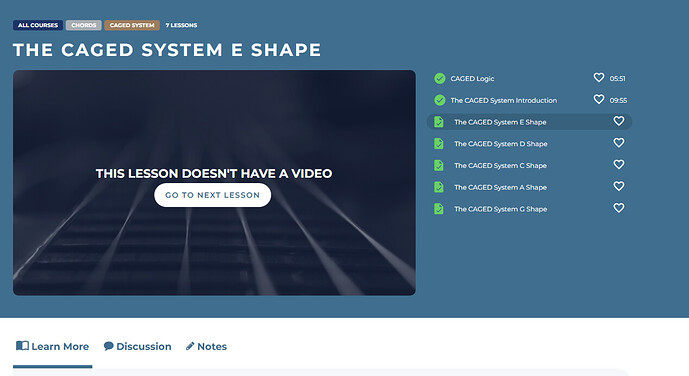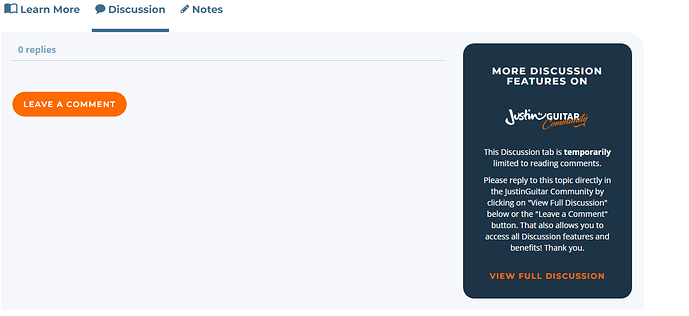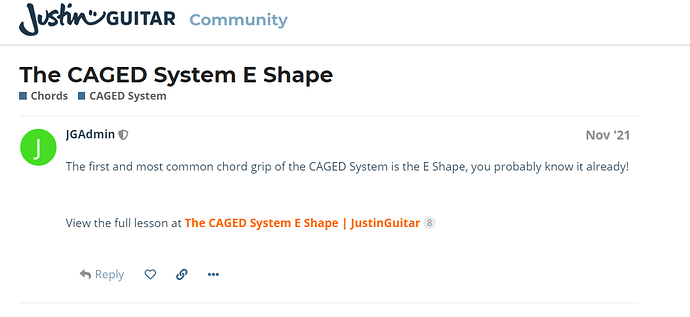View the full lesson at Major Scale Pattern 1 | JustinGuitar
Hi and Happy 2023!
First of all I can see why Justin Guitar is so popular.
- I am not sure if this is the best place to post this observation/question. I am an early intermediate player want to introduce scales and improvisation into my repertoire. I find it hard to find a “series” of lessons designed for this. They are sprinkled around with a lot of other bits that are no doubt important, but seems like an round about way of approaching “scales and intro to soloing”.
Any guidance appreciated!
- I can find Justin’s lessons here, on the app, on YouTube, and probably other places. Sometimes the material is older, other times recent. Any advice on how to navigate or focus most efficiently? Bouncing around always produces something
useful but sometimes tangential to what I am looking for and feels inefficient at times.
Perhaps a short video from Justin to explain his legacy stuff and fresh stuff and how best to utilise?
All the best from Cape Town!
Micheal
Welcome to the Community.
Sounds like you have just discovered Justin and by the look mainly via YouTube.
The best way to familiarise yourself with Justin’s web site is to start with the lesson map.
https://www.justinguitar.com/site-map-and-lesson-structure
This will pretty much show where everything is and how Justin progressively builds skill sets as you progress.
In respect of scales and improvising Justin cover these in a number of modules throughout the grade structure, from early introduction of the major scales and improvising during the beginners courses, to more focused modules like Blues Lead, Major Scale Maestro and the CAGED system.
If you have not done so already I would strongly suggest you start at the very beginning of Justin’s structure and work your way up to your current level. This will not only allow you to become accustomed to how things are interwoven but will most likely cover some material that is new to you and be of good value to you development.
As an “early intermediate” player you should be able to go through the material fairly quickly and reaffirm you foundations skills, during which time you will encounter Justin’s tasters for scales and impro which you can build on in later modules.
The lesson map will show you the areas of interest you are after but if you jump straight in, you may be missing some core skills that will have been introduced earlier. And as the web site in 99% free you’ve nothing to lose.
Hope that helps, any questions just holler.
Cheers
Toby
![]()
@Rock_Hammer Welcome to the community Michael.
To add to Toby’s link, here is another overview.
Justin teaches introductory lessons on minor pentatonic and major scales in the beginner course. Further along the line he has fuller courses on both, spread across several modules. He also has a crucial video:
The idea in brief: if you have learned a scale pattern but can not do anything musical with it do not learn any new patterns,
You may have follow up questions - go for it. If you need help, just ask.
I hope that helps.
Cheers ![]()
| Richard_close2u | JustinGuitar Official Guide, Approved Teacher & Moderator
Hi Toby and Richard,
Man I am impressed and appreciative of such quick replies. Thank you.
After reading your posts, and listening to some of Justin’s thoughts in general and his intro to the G major scale, I just finished goofing around with a backing track from “wikiloops” and really enjoyed it. As a campfire player with a very mediocre voice (but I do enjoy singing) it is a fun and profound change to simply add some basic lead type stuff. I also think that playing along will reinforce my basic memorization of the scale itself.
Anyhow, I do wish there was a “so, you want a break from your strumming and singing and get launched into basic soloing” module where it was all in one spot. That said, I will become reasonably proficient on G major scale in first position, being careful to LISTEN and have fun, before moving on.
I do want to contribute, or buy something, or otherwise pay some money to you guys.
Thanks again for the helpful and quick responses. Again impressive and appreciated. I will try not to overly take advantage of that!
Michael contributions are the easy part. First you could start by telling folk about yourself and your guitar journey here, as many others have done.
Folks also share knowledge and experience, so if you see a post where you think you could help out, don’t be shy and offer advice if you can. Likewise by asking questions you may also be helping folks who are struggling in the same area but never thought of reaching out. The response you get will be share by others and be of net benefit to those at that stage of their journey and those that jump on board in the future.
Some times that is the best way to pay, not with hard cash but by “paying it forward” as Justin likes to call it. Sharing knowledge and experience is priceless and costs but a few seconds. Simples !
![]()
As you have discovered already, every lesson has a corresponding link to this community, so just hit the discussion tab, then the View Full Discussion “box” to find your way here.
Saves a lot of searching.
Thats lovely. I completed a bit of the profile info but not sure that translates into “introducing” myself. If there is one thing I struggle with more than improving my guitar is anything remotely to do with social media. My mind just doesn’t work that way apparently!
That goes for me as well, guess that’s why I have been here for nearly a decade !
![]()
I just started Grade 4 and learned the 1st Major scale pattern. Justin’s example is in the key of G. I have a silly question because I have a terrible habit of going to other YouTube videos to confirm what I have learned.
If I apply this same pattern, but let’s say starting on the 5th fret of the E string (A note), would this be calling it the major scale in the Key of A? I would keep the same major shape/pattern but just begin everything on the A note.
For example, if someone told me to play the major scale in the key of B, can I apply this same pattern/shape anywhere on the fret as long as it starts on B because B would be the root note? Man, asking questions about this in writing is tough, lol.
Yes!
Each pattern has a root note. Start that pattern on that root note and its that scale.
So you have 12 frets on the E string, pattern 1 would be any of those 12 notes/keys if started on that notes fret.
The trick next is to learn the other patterns so you can play any key in the same position just by using the right pattern that hits the root note under your hand.
Thank you! Things are adding up! Slowly lol
Yes that is the nice thing about the guitar. Once you learn a scale pattern you know it in all 12 Keys just by moving the root.
Hey Jesse,
Just to add to what @stitch said.
Certainly not a silly question. Quite.the opposite. You’ve discovered the first critical piece of building your mental framework on the guitar : root notes.
Cheers Shane
Would that then be a change of “mode” too ?
R
Thanks Shane. As painstaking as it is, chipping away at memorizing where the notes are is starting to pay off a little.
@Libitina it applies to everything on guitar. This is how the CAGED system works and the foundation of how a guitar fret board is laid out.
No, you’d be playing the same scale patter / mode with a new root note
If you played this pattern (1) then moved up the fret using the same scale but patter 2 that could be said to be changing mode ( but not the Ionian, Dorian, Phrygia kinda mode…)
Hi Rob,
Maybe I misunderstand you, but you have modes in series and modes in parallel… so I think that’s what Rick also means by it (I’m guessing)
Greetings
(Ps: this is a nasty modes bomb for some ![]()
![]() )
)
[Backs away slowly…]


